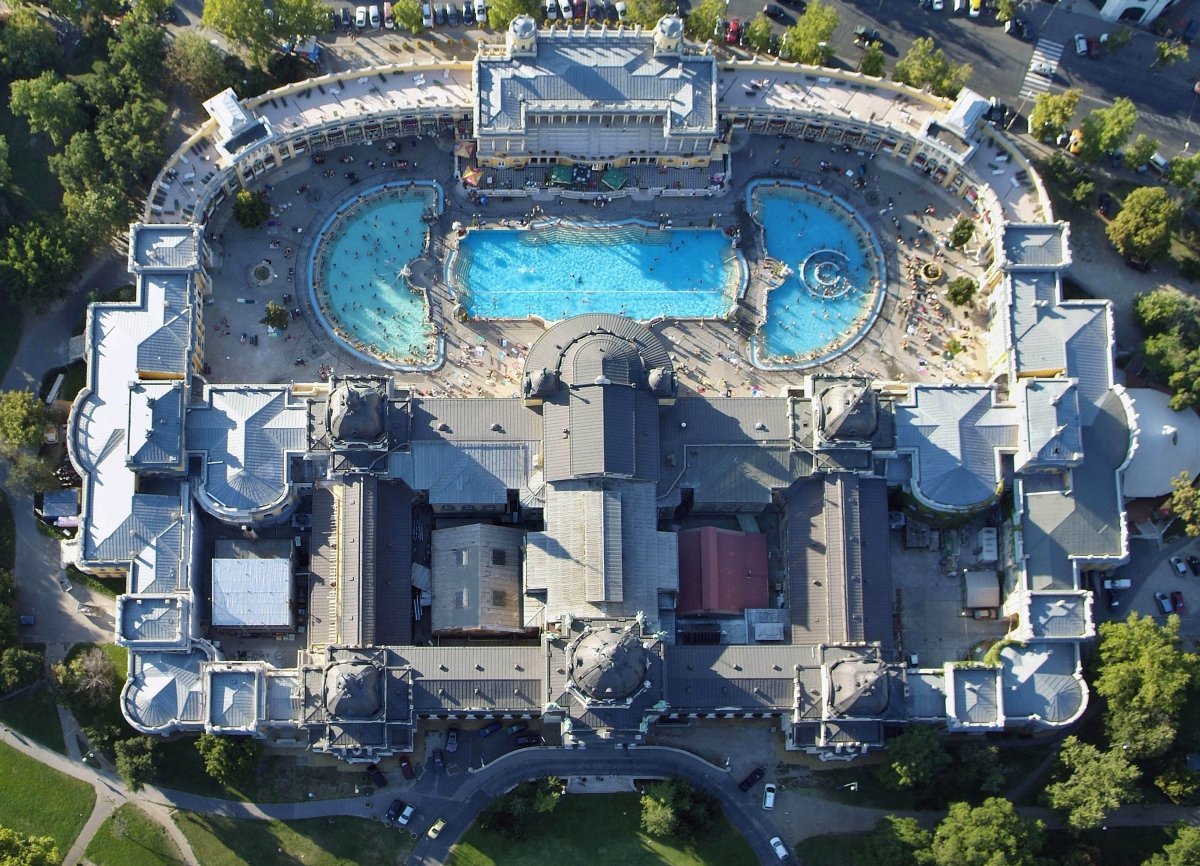Culture, history and entertainment meet in Budapest's spas. These buildings tell us about past ages and centuries, while their waters offer healing power and their outdoor pools provide pleasant cooling. The history of our first baths can be traced back to the Turkish occupation of Buda between 1541 and 1686.
The Rudas Thermal Bath owes its existence to a spring that could have already known by our Anjou rulers. Before the Ottoman conquest, the area was owned by the archbishops of Kalocsa, and its baths were remodelled by two pashas from Buda (Hadim Ali, and later Mustafa Szokoli), thus acquiring the Turkish-Islamic architectural forms, some of which can still be seen today.
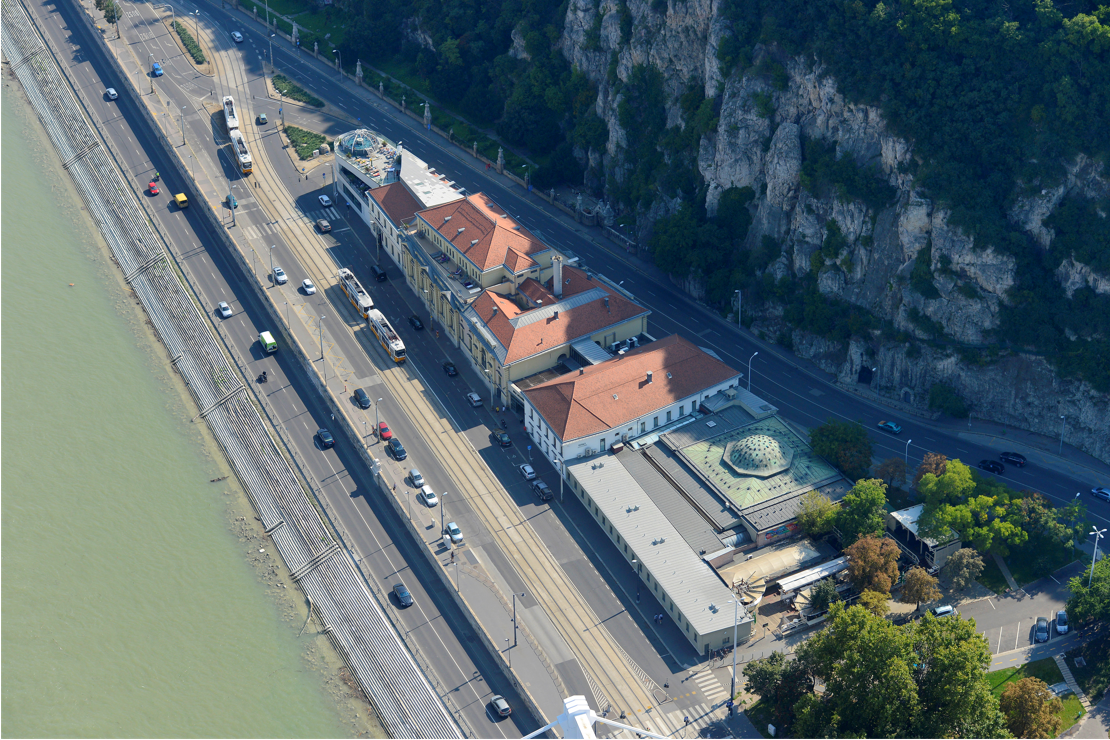
The Rudas Thermal Bath. The shadow of Gellért Hill is cast on its oldest, Turkish-era wing (Photo: Civertan)
The Turks originally called it the "Green Column Bath". After the ouster of the Ottoman Empire, it was neglected for a long time, then at the end of the 18th century it was expanded and became more and more popular. It got more and more wings, and then it was mutilated by the Second World War, so it had to be rebuilt. At the dawn of the regime change, Hollywood also took advantage of its special atmosphere (the opening scene of the 1988 Schwarzenegger film, Red Heat was shot here). It was renovated after the turn of the millennium, so it regained the classicist garb with which its previous master architects gifted it.
It could almost be a neighbour of Rudas, just a few hundred metres away we reach the Rác Thermal Bath, which has followed a similar life path: it was also built in the Turkish era, and its territory has been continuously growing. The octagonal dome hall similar to Rudas's represents the small wing built by the Turks (it is not a surprise that it was called the "small spa", Kücsük Ilica in Turkish). It escaped the recapture of Buda in 1686 almost unscathed.
The Rác Thermal Bath. Architectural features of different centuries in an interesting contrast (Photo: Civertan)
It had its heyday in the 19th century, its expansion only made it even more popular, especially the romantic and Neo-Renaissance expansion attributed to Miklós Ybl. Rác was also not spared by the Second World War, but after its subsequent reconstruction, its expansion continued with a modern wing following long, clean lines, which completes the facility with a hotel. The reopening of the bath is on track, so the long misery of its fate may end soon.
Moving further north, near the Buda embankment, the Király Thermal Bath hides among the bourgeois looking houses. It can not deny its origin: the Turkish bath, which has been preserved in the most authentic condition, was built with the intention of making it possible to bathe within the castle walls even during the possible siege of Buda. After the expulsion of the Turks, it received a Baroque wing.
The Király Thermal Bath. Its construction was completed by the same Pasha Mustafa Szokoli, who also built the Rudas Thermal Bath (Photo: Civertan)
It got its current name from the König Family that owned it in 1796. During its expansion in the 19th century (courtesy of Mihály König), a classicist part of the building and a closed courtyard was added. The bombings of World War II affected the Turkish pool hall less, but during the restoration, care was taken to preserve the historical authenticity. Over the past 70 years, its condition has deteriorated again, and its necessary renovation is on the agenda.
Continuing along the Danube Bank in Buda, we can take a look at the Lukács Thermal Bath. Originally, from the time of King Matthias, there was a small fort with a gunpowder mill, which controlled traffic on the road connecting Buda and Óbuda. Although the water's potential was discovered earlier, it was not until the second half of the 19th century that it was rebuilt into a real public bath. It used to have four specific tower buildings (typical of smaller fortresses) and many Moorish style features, but these have almost completely disappeared.
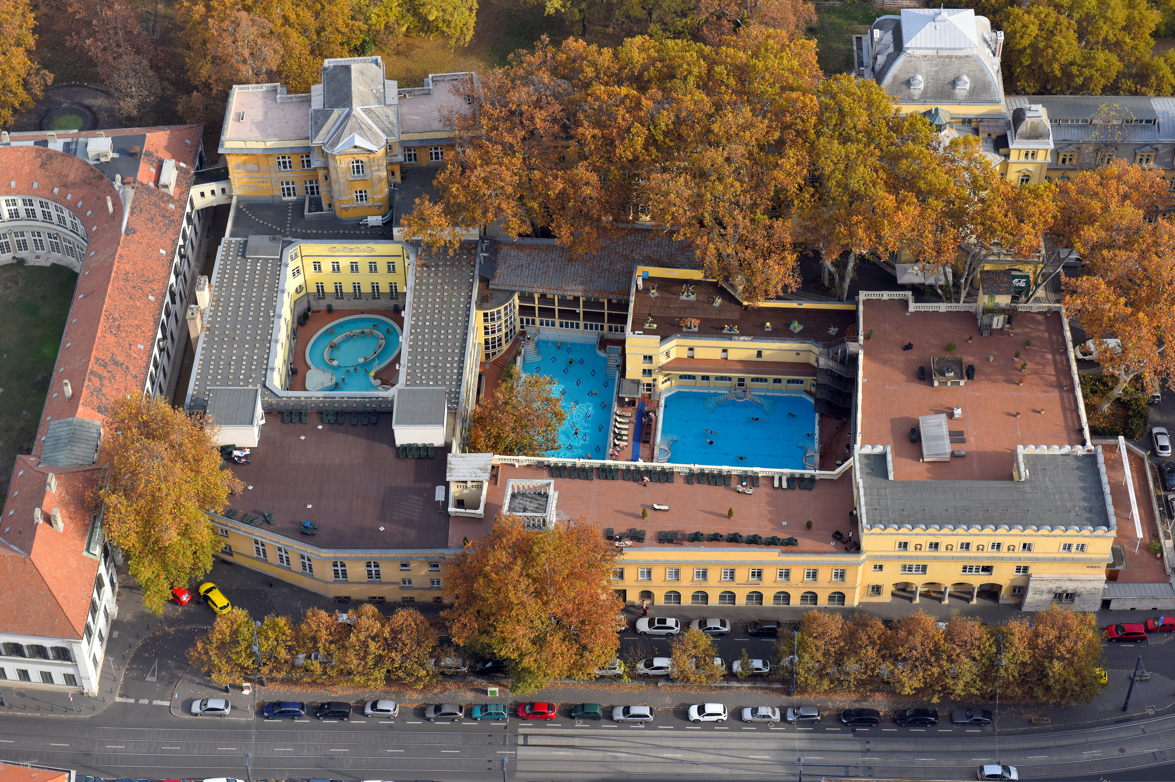
The Lukács Thermal Bath. The eclectic overall effect of the building is the result of the series of reconstructions (Photo: Civertan)
It gained its present form mostly thanks to the plans of the architect Rezső Hikisch in 1921, but it was also expanded during the years of socialism, and it was not by chance that it experienced its second golden age: Zoltán Kodály visited it almost every day, Gyula Illyés also mentions its pools and beautiful garden several times in his diary, but also Géza Ottlik also chooses the Lukács Thermal Bath as the opening location in one of his novels.
The aerial tour would not be complete without visiting the Gellért Thermal Bath: first in its territory Andrew II founded a hospital and spa. Later, the Turks used it enthusiastically, and after the recapture of Buda, it was given to the family physician of Emperor Leopold I. At that time, it was called 'Blocksbad' in German and 'Sáros Bath' in Hungarian, the latter due to the mud that settled at the bottom of the pools.
The Gellért Hotel and its bath: after its completion, it was one of the most modern thermal baths in Europe (Photo: Civertan)
The bath ceased to exist during the construction of today's Liberty Bridge, and then Budapest's city administration realised the design of the designated hotel-bath based on a conscious plan. The end result is the Art Nouveau masterpiece that can still be seen today, which they started to build in 1912 and completed in 1918 with the involvement of Russian prisoners of war from World War I. Many movies have been filmed in the building, and its virtual copy is even echoed in a computer video game.
We fly over to the Pest side, an unmissable stop is the Széchenyi Thermal Bath, also nicknamed "Szecska". It could not deny its time of birth either: in the decades after the Compromise, it was noticed that a well drilled in the area of today's Heroes' Square produced medicinal thermal water (this was later confirmed by the Gloriette Well). The idea of the bath was quickly conceived: in the first round, the central part of the building was completed in 1913 based on the Neo-Baroque designs of Győző Czigler.
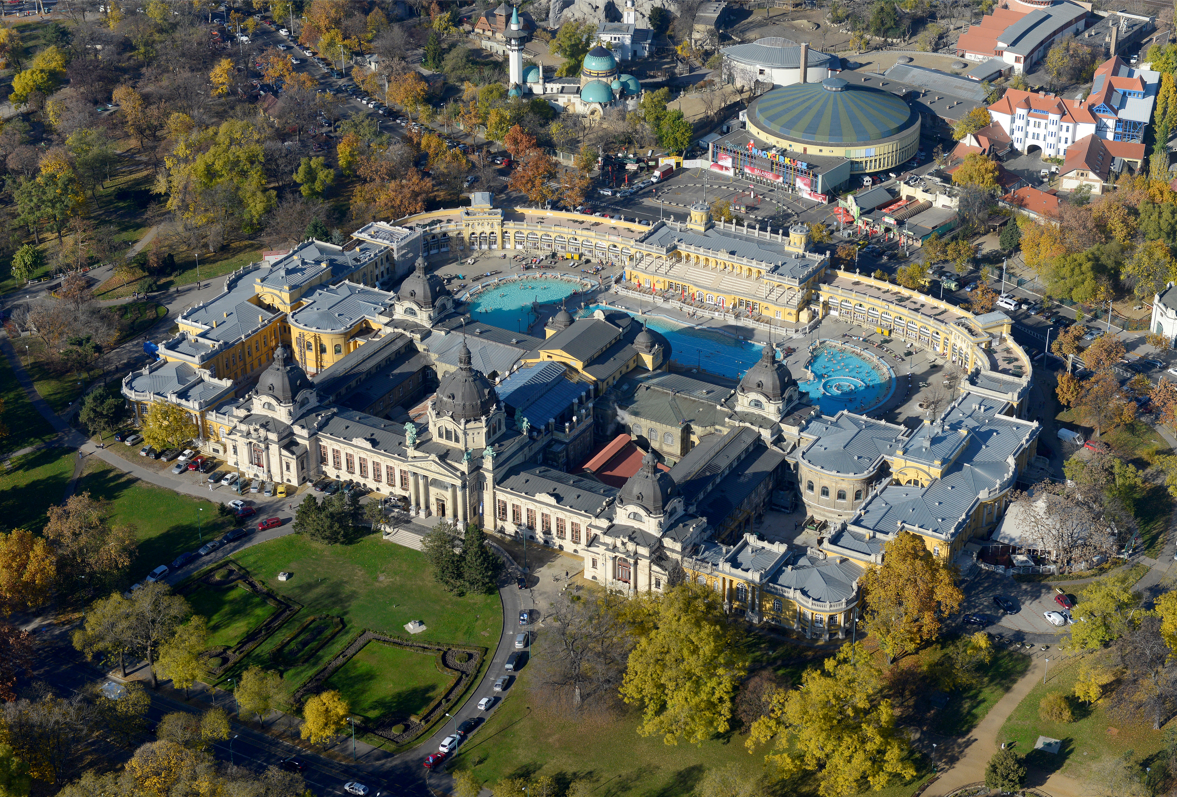
The Széchenyi Thermal Bath is one of the crown jewels of Hungarian historical architecture. The differences between the Neo-Baroque and Neo-Renaissance wings are clearly visible (Photo: Civertan)
Its popularity was so great that it was extended relatively quickly: based on the idea of Imre Francsek Jr., the Neo-Renaissance wing extending backwards was completed by 1927 - the three large outdoor pools are part of it. It is interesting that the thermal water of the bath also provides cooling for the hippos living in the neighbouring Budapest Zoo.
The Dandár Thermal Bath, built according to the plans of Kálmán Maróti, can give the impression of modesty from above. Its construction was justified by a Budapest decision of 1928, according to which several smaller, so-called public baths should be established throughout the city, which provide anyone with the opportunity to bathe at favourable prices (the construction of bathrooms in apartments only started to become common in the second half of the 20th century). The Dandár Street one was the first such public bath.
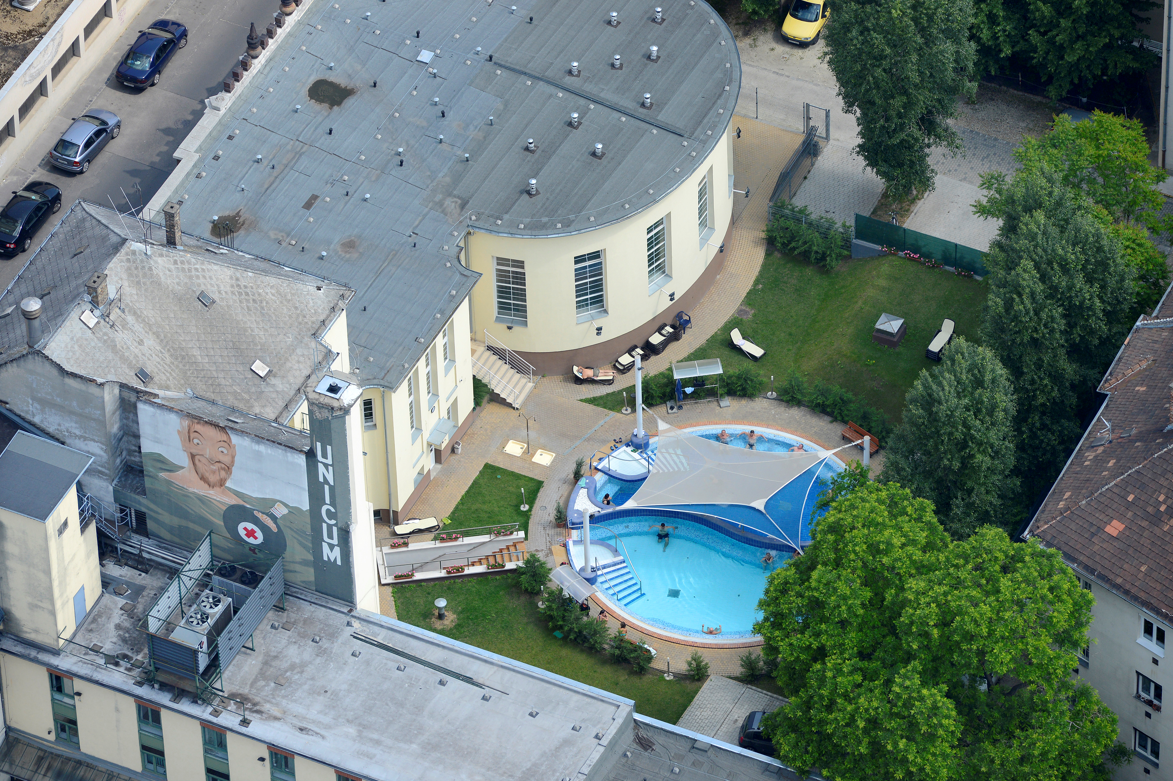
The Dandár Thermal Bath with its inner courtyard. The building is characterised by the simplified form of expressionism (Photo: Civertan)
At first, it did not have its own spring, the healing water had to be brought in by tank cars (mostly from the Széchenyi Thermal Bath). It had to wait until the 1980s, when - in addition to several transformations - it received its own spring from a nearby, high-quality thermal well established for this purpose, thus its self-sufficiency was solved.
Our last stop is an odd-one-out, it does not have the term "thermal bath" in its name, but the Alfréd Hajós National Pool Complex is also a prominent representative of Budapest's bathing culture. Its designer is also its later namesake, since Alfréd Hajós was an excellent architect in addition to his Olympic swimming skills. He knew well what swimming needs had to be met in order to create a modern facility.
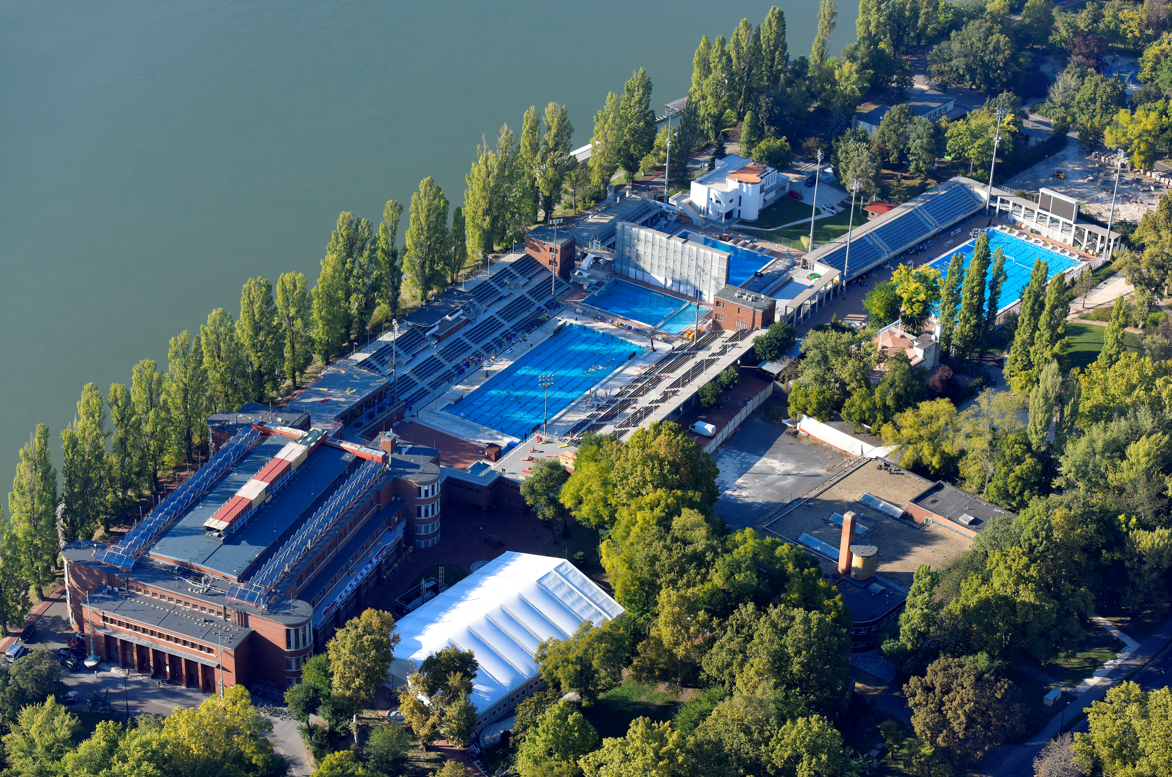
The Alfréd Hajós National Swimming Stadium. In the beginning, it was filled by the Margit Island spring and the water of the Danube at the same time (Photo: Civertan)
It was completed in 1930 and its covered swimming hall was handed over then, which was the largest such hall in Europe at the time. Later, it was gradually expanded with a diving facility and outdoor pools. It hosted matches of certain sports at many world competitions, including this year's World Swimming Championships.
The aerial photographs also bear witness to the high-level bathing culture of the Hungarian capital. Our baths have been with us for centuries, 16th-century Islamic architecture, and later Baroque, Classicism, Historicism, Art Nouveau, and even modern design are represented. They are not only part of our architectural heritage, but also part of Budapest's historical legacy.
Cover photo: The Széchenyi Thermal Bath from a top view (Photo: Civertan)

